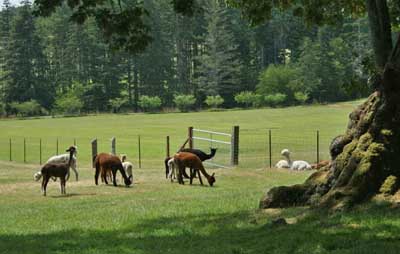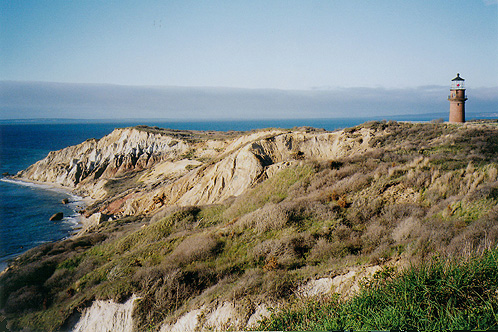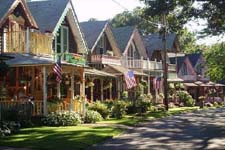With so many great reasons to visit the Island of Martha's Vineyard, it is difficult
to single out just three. Two of the best-known features of the Island are its beautiful
beaches and nature reserves and the magnificent, historic, whaling captains' homes
with their rose-strewn white picket fences. But the following are three equally
compelling sights to see and experience there:
Visit the Vineyard's working farms

Alpaca Farm, Martha's Vineyard
Martha’s Vineyard may be known as the summer playground for the rich and famous,
including presidents and their – some of whom own or enjoy beautiful
Martha's Vineyard vacation rentals. But it is equally well known for the
preservation of agriculture and farming, which has historically been an important
way of life on the Island.
First settled in the 1640s, Martha’s Vineyard residents spent the first 150 years
or so farming and fishing. Then shortly after 1800, the Vineyard became well known
for providing the captains, crew, and many of the services and supplies – including
food and produce -- that the whaling ships of Nantucket required to head out to
sea or when they returned with their catch.
After the demise of the whaling industry early in the 1870s, the Vineyard continued
to make a living fishing and farming, but these enterprises didn’t bring in much
money from the mainland. Because the Cape Cod Canal was not then in existence, many
Vineyarders assisted the sailing ships transporting goods from Boston to New York
through the treacherous waters around the Cape and Islands. This, however, wasn’t
financially rewarding, so Islanders continued providing for themselves on their
land and in the Island waters.
After World War II, tourism began to take off on the Vineyard as soldiers who had
been stationed there returned home to tell of the Island’s beauty. Fortunately,
many Islanders still put great importance on being self-sufficient and providing
“Island grown” produce and goods. Today, 28 working farms and countless backyard
gardens continue the tradition of those who founded the Island.
Farming on the Island is not limited to vegetables. For example, at Allen Farm Sheep
and Wool, you can purchase wool products. And at Chicama Vineyards, you can select
wine produced from grapes grown on the Vineyard.
Here is a
list of the working farms that are open to the public. Many have farm stands,
tours and special events.
If you visit Martha’s Vineyard’s working farms after the growing season is over
in the fall, you’ll find a new tradition taking root. The end of the harvest is
just the beginning for a group called the Martha’s Vineyard Gleaners. Gleaning is
an old agricultural tradition in which, after the harvest, farmers would open up
their fields, usually to the needy in the community, to pick what was left.
View the Cliffs and Lighthouse of Gay Head

Gay Head, Martha's Vineyard
A drive up through pretty, hilly Chilmark brings you to the town of Aquinnah, formerly
called Gay Head. Here you will find the 130 foot tall, beautiful, multi-colored
clay of the Gay Head Cliffs.
The Gay Head Cliffs are a National Landmark and for years were a favorite for those
wanting a challenging climb from the beach at the base. Today, however, climbing
is off limits due to the erosion toll this activity was taking on the face of the
cliffs.
At the top of the cliffs stands Gay Head Light. In 1796, heavy maritime traffic
passing through Vineyard Sound prompted Massachusetts State Senator Peleg Coffin
of Nantucket to request the construction of a lighthouse at Gay Head. The passage
between the Gay Head cliffs and the Elizabeth Islands was treacherous because of
the long underwater obstruction called Devil's Bridge that extends out from Gay
Head.
A 47-foot (57 feet to the top of the lantern), octagonal wooden lighthouse was erected
on a stone base, along with a wood-frame keeper's house, barn, and oil vault. The
light went into service on November 18, 1799.
Aquinnah has become celebrated as a center of Wampanoag Indian culture and of pride
and tradition among members of the tribe. You’ll find some Indian craft shops at
the top of the cliffs.
Enjoy Historic Cottage City and the Flying Horses Carousel

Cottage City, Oak Bluffs
The Martha's Vineyard Campmeeting Association, known as “the Campground” or "Cottage
City," is a National Landmark located in the center of the town of Oak Bluffs. Consisting
of hundreds of imaginative and colorful “gingerbread” cottages, the community contains
the most perfectly preserved collection of Carpenter Gothic style architecture in
the world. These truly unique Victorian "gingerbread" cottages are just a stone’s
throw from the famed Tabernacle.
The first campmeeting in what became known as Wesleyan Grove was held in 1835. In
subsequent years the congregations grew enormously, and many of the thousands in
attendance were housed in large tents known as "society tents," which were arranged
in a semicircle on Trinity Park.
Over time, families began leasing small lots on which to pitch their own individual
tents. In the 1860s and 1870s, the family tents were rapidly replaced with permanent
wooden cottages. At one time there were about 500 cottages; today there are just
over 300. Many of the cottages have been owned by the same families for generations.
The campground is a National Landmark.
The Tabernacle is the physical and spiritual center of the Campground. Architecturally,
the Tabernacle is a unique structure, with wrought iron arches and supports, two
clerestories with dozens of colored glass windows, and an octagonal cupola.
One very special highlight of the summer season on the Campground is Grand Illumination
held on a Wednesday evening in August. The cottages are adorned with colorful Chinese
and Japanese lanterns, and both a Community Sing and a band concert are held in
the Tabernacle. The Grand Illumination for 2015 will take place on Wednesday, August
19.
Visitors to the Cottage Museum can view the interior of a typical Campground cottage,
complete with period furnishings offering a glimpse of life on the Campgrounds in
the 1800s. Also on display are vintage photographs, a selection of stereoscopic
photos of Cottage City and the Campgrounds, along with other interesting documents
relating to the history of the Campground.
The Museum Shop has a wide selection of Campground-related souvenirs and gifts,
including books, calendars, paper and silk lanterns, sterling silver Campground
charms, toys, postcards and other interesting items.
For more information, visit the
Campmeeting Association website.

Flying Horses Carousel
While visiting the Campground, don't miss the nearby Flying Horses Carousel in the heart of Oak
Bluffs. The nation's oldest continuously operating carousel, the horses were hand-carved
in New York City in 1876 and brought to Martha's Vineyard in 1884. This historic
landmark is maintained by the Martha's Vineyard Preservation Trust.
The Flying Horses Carousel is open daily during the summer and on weekends in the
spring and fall. Rides are just $2.50.